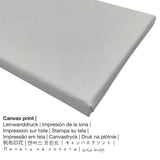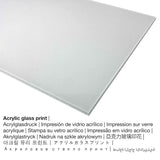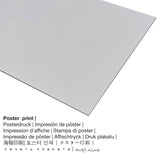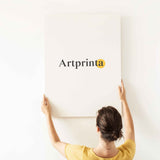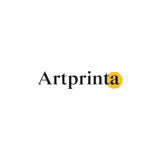Thomas Moran, 1881 - Green River Cliffs, Wyoming - mbipụta nka mara mma
Ụtụ gụnyere. Mbupu gbakọrọ na ndenye ọpụpụ.
Kedu ụdị ngwaahịa anyị na-enye ebe a?
a 19th narị afọ ihe osise mere site na onye ihunanya artist Thomas Moran in 1881. Nowadays, this work of art can be viewed in in the National Gallery of Art's art collection, which is the museum of the US-American nation that preserves, collects, exhibits, and fosters an understanding of works of art. We are delighted to reference that the ngalaba ọha work of art is supplied with courtesy of National Gallery of Art, Washington.The creditline of the artwork is the following: . On top of that, alignment is landscape with a ratio of 5: 2, nke pụtara na ogologo bụ ugboro abụọ na ọkara ogologo karịa obosara. The painter, etcher, explorer, lithographer Thomas Moran was a North American artist from United States, whose art style was mainly Romanticism. The Romanticist artist was born in the year 1837 in Bolton, Bolton, England, United Kingdom and passed away at the age of 89 in 1926 in Santa Barbara, Santa Barbara county, California, United States.
Ngwa ngwaahịa nke ị nwere ike họrọ na:
Nchịkọta nhọrọ ngwaahịa na-enye gị ohere ịhọrọ nha na ihe ị họọrọ. Nha na ihe ndị a bụ nhọrọ anyị na-enye gị maka nkeonwe:
- Mbipụta kwaaji: A canvas direct print is a printed canvas mounted on a wood stretcher. The great advantage of canvas prints is that they are relatively low in weight, which implies that it is quite simple to hang the Canvas print without the support of any wall-mounts. Canvas prints are suitable for any kind of wall.
- Mbipụta enyo acrylic: A glossy print on acrylic glass, which is sometimes described as a UV print on plexiglass, will turn the original work of art into magnificient décor. Further, the acrylic glass fine art print makes a distinct alternative option to canvas or aluminium dibond prints. The work of art is being manufactured with the help of state-of-the-art UV print machines. With a glossy acrylic glass art print contrasts and also granular image details become recognizeable with the help of the precise tonal gradation. The acrylic glass protects your chosen fine art print against light and heat for up to 60 years.
- Mbipụta nke aluminom: An Aluminium Dibond print is a material with an outstanding effect of depth. The non-reflective surface creates a contemporary impression. The Aluminium Dibond Print is the best start to fine reproductions with aluminum. The colors are bright and luminous in the highest definition, details of the print are clear and crisp. This print on aluminium is the most popular entry-level product and is an extremely sophisticated way to display fine art prints, because it puts 100% of the viewer’s attention on the image.
- Poster (akwa akwa akwa): A poster is a printed cotton canvas with a slight surface texture, that reminds the actual work of art. The printed poster is excellently suited for framing your fine art print using a customized frame. Please bear in mind, that depending on the absolute size of the poster print we add a white margin 2 - 6cm round about the print, which facilitates the framing with your custom frame.
Disclaimer: We try our utmost to describe our art products as precisely as it is possible and to demonstrate them visually on the respective product detail pages. Nevertheless, the pigments of the print products, as well as the printing can vary somehwat from the image on the device's monitor. Depending on your screen settings and the condition of the surface, not all color pigments are printed as realistically as the digital version on this website. Given that all our art reproductions are printed and processed manually, there might also be slight variations in the size and exact position of the motif.
Nkọwa ihe ahaziri ahazi
| Ụdị ngwaahịa: | ezi nka mmeputakwa |
| Usoro mmeghari: | dijitalụ mmeputakwa |
| Usoro mmepụta: | mbipụta dijitalụ |
| Production: | emere na Germany |
| Stockdị ngwaahịa: | a na-achọ |
| Eji ngwaahịa a chọrọ: | ihe ndozi mgbidi, gallery mmeputakwa nka |
| Nhazi nke ihe nka: | nhazi odida obodo |
| Oke akụkụ: | ogologo: obosara 5:2 |
| Nkọwa nke oke akụkụ: | ogologo bụ ugboro abụọ na ọkara ogologo karịa obosara |
| Nhọrọ dị: | acrylic glass print (nwere ezigbo mkpuchi iko), mbipụta akwụkwọ mmado (akwụkwọ kwaaji), mbipụta ọla (aluminium dibond), mbipụta akwụkwọ. |
| Mpempe akwa akwa (akwa akwa na etiti ihe ndọtị) nha: | 50x20cm - 20x8", 100x40cm - 39x16", 150x60cm - 59x24" |
| Mbipụta iko acrylic (nwere ezigbo mkpuchi iko) dị iche iche: | 50x20cm - 20x8", 100x40cm - 39x16", 150x60cm - 59x24" |
| Ụdị akwụkwọ mmado (akwụkwọ kwaaji) dị iche iche: | 100x40cm - 39x16" |
| Mbipụta aluminom (aluminium dibond ihe) dị iche iche: | 50x20cm - 20x8", 100x40cm - 39x16" |
| Nhazi mbipụta nka: | agunyeghi |
Iberibe nkọwa nka
| Aha nka: | "Green River Cliffs, Wyoming" |
| Nhazi: | sere |
| Okwu nche anwụ: | nkà nke oge a |
| Time: | 19th narị afọ |
| Afọ nka: | 1881 |
| Afọ nka: | gbara afọ 130 |
| Ụlọ ihe ngosi nka / mkpokọta: | Nnukwu osisi nke Art |
| Ebe ngosi nka: | Washington DC, Njikota Obodo Amerika |
| ibe weebụ: | Nnukwu osisi nke Art |
| Akwụkwọ ikike nka: | ngalaba ọha |
| Site n'aka: | National Gallery of Art, Washington |
Nchịkọta ihe nkiri
| Ihe nkiri: | Thomas Moran |
| Aha nka ndị ọzọ: | Moran, Yellostone Moran Thomas, thos. moran, Moran Thomas, Thomas Moran |
| okike nke onye nka: | nwoke |
| Obodo onye nka: | American |
| Ọrụ onye na-ese ihe: | lithographer, explorer, etcher, painter |
| Mba onye si: | United States |
| Nhazi nke onye nka: | omenkà nke oge a |
| styles: | Ihunanya |
| Afọ ọnwụ: | 89 afọ |
| A mụrụ: | 1837 |
| Obodo ọmụmụ: | Bolton, Bolton, England, United Kingdom |
| Afọ ọnwụ: | 1926 |
| Nwuru na (ebe): | Santa Barbara, Santa Barbara county, California, United States |
© Nchekwa ikike nwebisiinka, www.artprinta.com (Artprinta)
General specifications by National Gallery of Art (© - National Gallery of Art - www.nga.gov)
Oil on canvas, 63.5 x 157.5 cm (25 x 62 in.)
Overview: In June 1871, Thomas Moran, a gifted young artist working in Philadelphia, boarded a train that would take him to the far reaches of the western frontier and change the course of his career. Just a few months earlier he had been asked to illustrate a magazine article describing a wondrous region in Wyoming called Yellowstone—rumored to contain steam-spewing geysers, boiling hot springs, and bubbling mud pots. Eager to be the first artist to record these astonishing natural wonders, Moran quickly made plans to travel west.
Yellowstone was Moran's ultimate destination in the summer of 1871, but before he reached the land of geysers and hot springs, he stepped off the train in Green River, Wyoming, and discovered a landscape unlike any he had ever seen. Rising above the dusty railroad town were towering cliffs, reduced by nature to their geologic essence. Captivated by the bands of color that centuries of wind and water had revealed, Moran completed a small field study he later inscribed "First Sketch Made in the West." Moran went on to join F. V. Hayden's survey expedition to Yellowstone and complete the watercolors that would later play a key role in the Congressional decision to set the region aside as America's first national park. Over the years, however, the subject Moran returned to repeatedly was the western landscape he saw first—the magnificent cliffs of Green River.
Green River, Wyoming, was a bustling railroad town when Moran arrived in 1871. Three years earlier, Union Pacific construction crews had arrived intent on bridging the river. Their tent camp quickly became a boomtown boasting a schoolhouse, hotel, and brewery. Yet none of these structures appear in Moran's Green River paintings. Even the railroad is missing. Instead, the dazzling colors of the sculpted cliffs and an equally colorful band of Indians are the focus. In a bravura display of artistic license, Moran erased the reality of advancing civilization, conjuring instead an imagined scene of a pre-industrial West that neither he nor anyone else could have seen in 1871. Ten years after his first trip west, Moran completed Green River Cliffs, Wyoming, the most stunning of all his Green River paintings.
The National Gallery of Art is honored to announce the acquisition of Thomas Moran's Green River Cliffs, Wyoming, 1881, a gift of the Milligan and Thomson Families.


